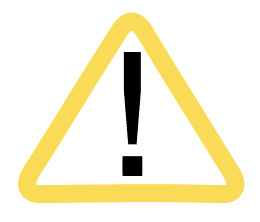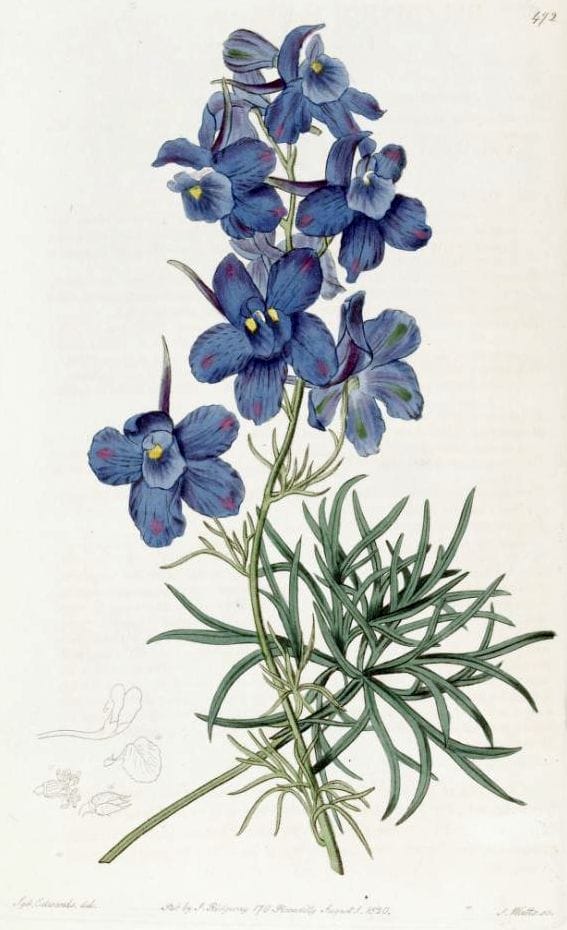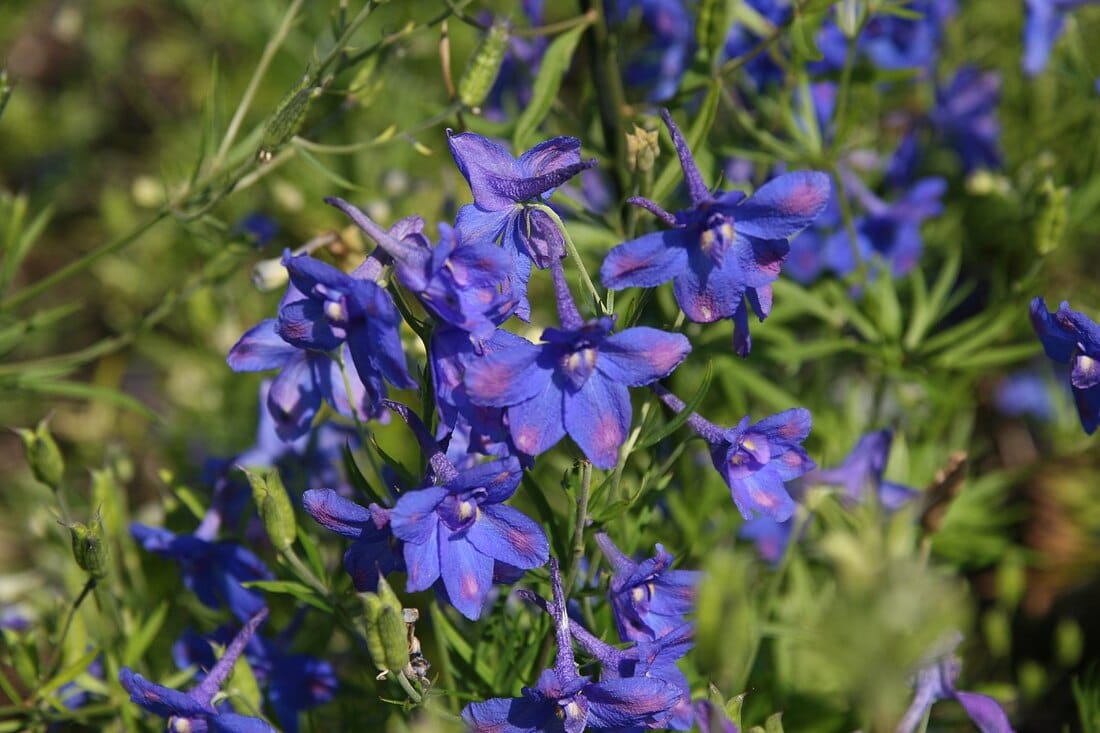Delphinium grandiflorum, Bya rkang བྱ་རྐང༌Bya rkang, བྱ་རྐང༌ (Tibetan)Dakhangu (Sanskrit); Asbarg (Hindi) D. grandiflorum: Cui Que Hua (TCM) D. kamaonense: Zhan Mao Cui Que Hua (TCM) |

|
 Delphinium grandiflorum
Delphinium grandiflorum(The Botanical Register, Edward’s, 1820)
 Delphinium grandiflorum ‘Dwarf Blue Butterfly’
Delphinium grandiflorum ‘Dwarf Blue Butterfly’(Photo by David Stang) (Wikimedia)
Botanical name:
Delphinium grandiflorum
The Delphiniums are difficult to classify and have many varieties. Over 2 dozen species are reported in the Himalayas and Tibet.
In Tibetan, Bya rkang is regarded as one type of Ti Mu Sa (Delphinium caeruleum), of which there are 3 main types recognised:
- Lo btsan chen po: small type with pale blue-white flowers, found at high altitude; D. albocaeruleum, D. chrisotrichum, D. tenii
- Gyu lung: pale blue flowers, found in lower altitudes
- Bya rkang: dark blue flowers, found in lowest altitude of the three
Kletter also lists D. denudatum as one of the plants collected as Bya rkang.
Other species of Delphinium recognised in Tibetan Medicine include Bya rgod spos (Delphinium brunonianum), Ga bur tis lo (Delphinium trichorum), Ti mu sa (Delphinium caeruleum), Lo btsan pa (D. albocaeruleum), and Spyang dug ma.
Other species used from different areas for Bya rkang include:
- In Nepal, D. kamaonense (D. grandiflorum group)
- In India, D. vestitum (syn. D. elatum) (Kletter)
- In Bhutan: D. drepanocentrum
- Kashmir, Ladakh: D. cashmerianum
- In Mongolia: D. cheilanthum, D. crassifolium
Khare (Indian Medicinal Plants) lists both D. denudatum and D. vestitum as as source of the Ayurvedic drug Nirvisha, suggesting D. denudatum and D. grandiflorum may be largely synonymous (as D. vestitum has also been used as a source of Bya rkang). We have separated them, primarily due to the extensive use of D. denudatum in Unani and Ayurveda, and the relatively sparse use (mostly externally) of D. grandiflorum (Bya rkang) in Tibetan Medicine.
Parts used:
Aerial parts
Sometimes the root or Seed
Temperature & Taste:
Cool, dry. Bitter (Warm in TCM). Toxic (Seed is most toxic)
Uses:
1. Clears Heat and Damp: (Tibet, TCM)
-Diarrhea, Enteritis, Dysentery
-clears pus in wounds; Sores, welling Abscess
2. Clears Wind-Damp, Stops Pain:
-Wind-Damp muscles and joint pain (D. grandiflorum, TCM)
3. Kills Parasites: (Tibet, TCM)
-applied to kill Lice
-powdered flowers mixed with mustard oil have been used to kill lice.
4. Externally:
-the aerial parts are applied to dry damp and heal wounds
-root applied externally to bruises
-Hemorrhoids
Dose:
Mostly used externally
Comment:
The Delphiniums are similar in appearance to the Aconites, and are often found growing in similar areas. Both contain Diterpene Alkaloids and both are toxic, although the Aconites are generally far more toxic.
Main Combinations:
Major Formulas:
Cautions:
1. Very toxic in overdose. Contains aconite-like alkaloids. The seeds are the most toxic part.
2. Overdose causes breathing difficulty, spasms and paralysis
